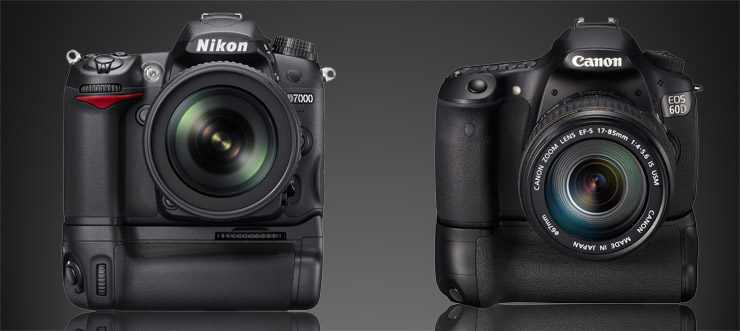If you’re trying to decide which new camera to buy, your decision just got substantially harder. Yesterday’s announcement of the Nikon D7000 comes only a few short weeks after the unveiling of the Canon 60D, a camera that seems to be its closest competitor. With the D7000, Nikon has made some important improvements over their previous mid-line models (D90, D5000), and consequently, has produced one of their most impressive cameras in years.
[For more information about the 60D and how it compares to other Canon models, click HERE or use the article menu on the home page. For a comparison of the D7000 and the Canon 7D, click the preceding link.]
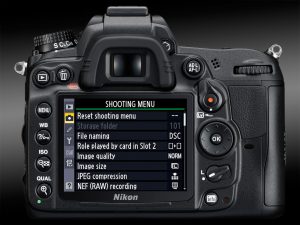
To begin with, Nikon has finally increased the resolution of their mid-range APS-C sensor from 12.2 up to 16.2 megapixels. This is still shy of the 18 megapixels found in Canon’s most recent 3 bodies (the 7D, Rebel T2i, and the 60D), but it’s getting quite close and is a very respectable resolution. With a lower pixel density (Nikon’s sensor is also slightly larger than the Canon, as usual), Nikon has the potential for improved high ISO performance, though time and tests with production models will tell what the practical difference really is. In the past, Nikons have performed quite well in low light.
The Canon 60D and Nikon D7000 both use AF systems based on 9 cross-type AF sensors, but the Nikon adds and additional 30 focusing points, and couples them with a 2016 pixel RGB sensor and 3D processor that can theoretically track a subject by its color in addition to its direction of movement. A similar system has been used in the Nikon D3 with some success.
Nikon has also made a significant leap forward in video functionality. The D7000 now offers full high-definition video (1080p) recording, though only at 24 fps. This will be sufficient for many people who are interested in film making, but standard video frame-rate in the USA is 30fps for most broadcast quality work, which may make it difficult to edit video from the D7000 in with video shot from professional video camera footage for news work. Still, even this will be a very welcome development to those who use their SLR for video, as most previous models (with the exception of the D3100) had been limited to 720p. Unfortunately for those interested in slow-mo video, the D7000 does not yet offer 60fps at 720p as Canons do, but this may change with firmware updates in the future (just as 24 fps was added to the Canon 5D Mark II). Furthermore, the D7000 offers full time auto-focus for video mode. [Update: Initial reviews of the D7000’s video AF have been luke-warm, at best]
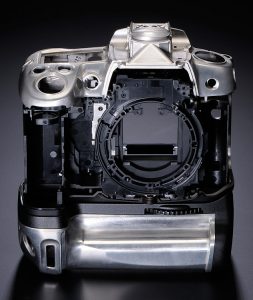
While Canon seems to have backed-off of the professional market slightly with the 60D, the D7000 seems like a bulked up version of the D90, similar in many ways to the D300s. The 60D dropped the 50D’s magnesium alloy body in favor of a plastic one, while the D7000 has a body that is mostly metal, an upgrade over the D90’s plastic. Similarly, the new battery grip for the D7000 (which also sports a new model of battery) has metal reinforcements for strength and proper weight distribution. In addition, the rubber grip material on the D90 is heavier, with a more comfortable, durable feel. However, the D7000 is still relatively small compared to the D300s and Canon 7D, much closer in size to the D90.
The D7000 also sports a pentaprism viewfinder that is larger, brighter and easier to use than those of entry level models (eg, D3100), and similar to those found on the Canon 7D and 60D. Also like the 60D (and 7D), Nikon has added an electronic level in the viewfinder to help keep your shots from being skewed, which helps reduce cropping and the associated resolution loss.
As Canon did with the 60D, Nikon opted for the use of SD cards instead of the larger Compact Flash. The D7000, however, is endowed with two SD slots, with the option of recording RAW to one and JPG to the other.
Here’s a comparison of some of the standard features:
| Canon 60D | Nikon D7000 | Canon 7D | |
|---|---|---|---|
| Body Price | $999 | $1499 | $1599 |
| Body Material | Polycarbonate and Stainless Steel | Magnesium Alloy & Polycarbonate | Magnesium Alloy |
| LCD Size / Resolution | 3.0" 1,040,000 pixels | 3.0" 921,000 pixels | 3.0" 920,000 pixels |
| LCD Articulated? | Yes | No | No |
| Sensor Size | 14.9 x 22.3mm (APS-C) | 15.8 x 23.6mm (APS-C) | 14.9 x 22.3mm (APS-C) |
| Crop Factor | 1.6x | 1.5x | 1.6x |
| Sensor Resolution | 18 Megapixels | 16 Megapixels | 18 Megapixels |
| ISO Range | 100-6400 +12800 | 100-6400 +12800 +25600 | 100-6400 +12800 |
| Total AF Focus Points | 9 | 39 | 19 |
| Cross-Type AF Sensors | 9 | 9 | 19 (dual diagonal) |
| AF Light Level Range | -.05 to +18 EV | -1 to +19 EV | -.05 to +18 EV |
| Metering System | 63 Zone Point Linked Evaluative 6.5% Center Weighted 2.8% Spot | 2016 pixel RGB Metering Sensor | 63 Zone Point Linked Evaluative 9.4% Center Weighted 2.3% Spot |
| Exposure Compensation | 1/2 or 1/3 stops via thumb dial | 1/2 or 1/3 stops via button-dial combo | 1/2 or 1/3 stops via thumb dial |
| Max Frame Rate : RAW (14-bit) | 5.3 fps | ? | 8 fps |
| Max Frame Rate : RAW (12-bit) | n/a | 6? | n/a |
| Max Frame Rate : JPG | 5.3 fps | 6? | 8 fps |
| Max Burst Duration RAW (at highest frame rate) | 16 | 100? | 15 |
| Max Burst Duration JPG (at highest frame rate) | 58 | 100 | 94 |
| Shutter Speed Range | 1/8000th - 30 sec. +bulb | 1/8000th - 30 sec. +bulb | 1/8000th - 30 sec. +bulb |
| Maximum Flash Sync Shutter Speed (standard flash) | 1/250th sec. | 1/250th sec. | 1/250th sec. |
| HD Video Resolutions | 1080p, 720p | 1080p, 720p | 1080p, 720p |
| Available HD Video Frame Rates | PAL and NTSC 24/25, 30 at 1080p 24/25, 30, 60 at 720p | 24 fps at 1080p, 24, 30 fps at 720p | PAL and NTSC 24/25, 30 at 1080p 24/25, 30, 60 at 720p |
| Firmware Sidecar Available | No | No | Under Development |
| Media Type | SD / SDHC / SDXC | SD / SDHC / SDXC (2 slots) | Compact Flash |
| Weight | 675g (body only) | 690g (body only) 780g with battery | 820g (body only) |
| Viewfinder Coverage | 96% Frame, .95x magnification | 100% Frame, .95x magnification | 100% Frame, 1.0x magnification |
Tentative Conclusions
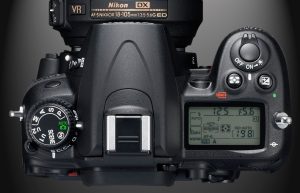
As I Nikon shooter, I’d probably pass over the D300s to snatch up one of the new D7000s. It has the construction of a pro-camera (or at least, a very high quality semi-pro), a great new sensor and processor, an excellent viewfinder, improved video performance, and a great auto-focus system (technically, it has fewer focusing points than the D300s, but it’s a small enough difference as to be negligible in practical use). The controls should be familiar to Nikon users, though any new camera will require a little adjustment. Between the D90 and the D7000 there is no comparison; the D7000 is simply a better class of camera…. a pro’s machine compared to an advanced amateur’s.
As a Canon shooter, I’d be impressed with the D7000, but probably not enough to switch to Nikon, especially if I’d already invested in Canon lenses. Although the Nikon has a more heavy-duty build, the Canon 60D is still superior in couple of important ways: it offers a higher resolution sensor, better video capabilities, and of course, an articulated LCD. Semi-pros may be interested in a metal body of the D7000, but many advanced amateurs will be happy not to carry the extra weight. If a magnesium body were of particular importance to me, then it’s worth noting that the Nikon will cost about $1200, while the Canon 7D now costs only $1529, and is an even better camera than the 60D.
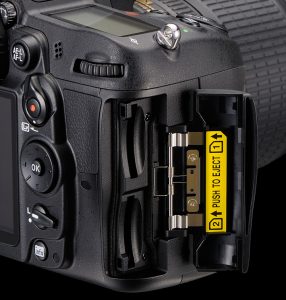
If I had no initial bias towards Nikon or Canon, and were deciding between the D7000 and the Canon 60D, I might give my decision to the D7000. For a minimal price difference ($100), the D7000 provides the metal body, faster shooting bursts, dual card slots, continuous AF for video and a very impressive looking AF system for still shooting, and very similar features otherwise. My only major reservation would be the lower resolution sensor, since I expect that within 2 years, the higher end SLRs will be using 40 megapixel sensors; it’s a shame to be starting off on the low end of the spectrum in that regard. For most practical purposes, though, 16 megapixels will be more than enough, so I’d be confident in purchasing it.
Since neither camera has been released yet to the general public, a lot remains to be said about the real world use of each. Time and testing will give us further details, but I think that it is clear that we’ve come to an age in which the differences in image quality and substantive features between most digital SLRs within the same class are becoming very minor issues. It’s time to simply get a camera and start shooting… and let what really matters shine though: the person behind the camera!

